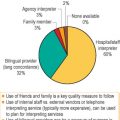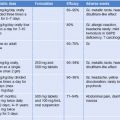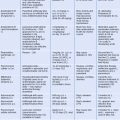CHAPTER 24 HIV Infection
Background
Many immigrants to the United States come from countries with a high seroprevalence of HIV, including those in Africa, Asia, and Eastern Europe. There are few data concerning the prevalence of HIV infection among specific immigrant populations residing in the US since The Centers for Disease Control and Prevention (CDC) report surveillance data by race and ethnicity only, rather than by country of origin. Regional and state-specific data, however, reveal that immigrant communities are disproportionately affected by the HIV/AIDS epidemic. People born outside of the United States are estimated to make up 12% of the general population of Massachusetts, yet of the 15 289 people living with HIV/AIDS in that state at the end of 2004, 2699 (18%) were foreign born. Twenty-six percent of those newly diagnosed and 41% of newly diagnosed females in 2004 were foreign born. In addition, the proportion of non-US-born individuals among annual AIDS diagnoses in Massachusetts increased from 9% in 1994 to 29% in 2003.1 The incidence of HIV/AIDS has also been reported to be increasing among Minnesota’s African-born communities. Less than 1% of Minnesota’s population is African-born, yet in 2004 19% of newly reported cases of HIV were among African-born individuals. Actual numbers may be higher, as fear and stigma prevent many individuals from being tested.2 As demonstrated by the above statistics, immigrants from countries with higher prevalence of HIV infection may have a large impact on healthcare systems, especially when they settle in states with a relatively low prevalence of HIV infection, such as Minnesota. The effect of immigration on prevalence of HIV infection within communities in the US is important to consider when strategizing AIDS services at local levels.
Hispanics living in the US are also affected disproportionately by HIV/AIDS. Although Hispanics made up 14% of the population of the United States through 2002, they accounted for more than 18% of AIDS cases since the beginning of the epidemic.3 At the end of 2004, Hispanics accounted for 17% of all people in the United States living with HIV/AIDS in the 35 areas with confidential name-based HIV infection reporting since 2000, and accounted for 20% of persons in the United States living with AIDS.4 Risk factors for HIV may vary with country of origin for Hispanics living in the US. Sexual contact among men is the primary cause of HIV infections among men born in Mexico and Central/South America. Hispanic women are most likely to be infected with HIV as a result of sex with men. Social and behavioral factors driving the HIV epidemic in Hispanic communities include poverty, denial, substance abuse, and sexually transmitted diseases.3
Immigration Law and HIV
The basic body of United States immigration law is contained in the Immigration and Nationality Act.5 In 1993, the Immigration and Naturalization Act required testing, and specifically barred individuals with HIV from admission to the United States. In 1999, the policy was revised, and HIV-infected refugees were allowed to enter the US with a waiver. Waivers are available to refugees entering the US, as well as for asylees and individuals who are the parent, spouse, or unmarried child of a US citizen or lawful permanent resident (LPR). The number of refugees that have entered the US through this waiver program remains small: 179 in 2000, 323 in 2001, 33 in 2002, 98 in 2003, and 360 in 2004 (personal communication, Department of State, Bureau of Population, Migration and Refugees).
Asylum may be claimed because of persecution based on belonging to a social group. In 1996, the INS officially stated that: ‘Aliens with HIV who are seeking asylum or withholding of deportation may be able to qualify for recognition as members of a “particular social group” if the evidence in the individual case supports such a conclusion.’ Clinicians may be asked to provide documentation of their positive HIV status or evidence of mental or physical sequelae of torture in the form of an affidavit as part of the applicant’s asylum application. Further information regarding clinician advocacy and the writing of medical and psychological affidavits has been published previously by Physicians for Human Rights.6 Information on the preparation of the clinician as an expert witness in immigration court can be found on the Boston Center for Refugee Health and Human Rights website.7
Further details on the Immigration and Naturalization Act can be found at the United States Citizenship and Immigration Services website: http://www.uscis.gov/portal/site/uscis Professionals familiar with these rules and regulations should be consulted as necessary for advocacy.
Eligibility to enter the US and risk for deportation
HIV infection is a reason for inadmissibility to the United States, with the exception of the waiver program discussed above. INA Sec 237(a) (1) (A) makes individuals deportable if they were ‘inadmissible at the time of entry;’ hence if someone was inadmissible for having HIV/AIDS at the time of entry, she or he is also deportable. An immigrant who has entered the US unlawfully after April 1, 1997, can be removed for being HIV infected. Public charge is also a deportation ground, so if someone becomes a public charge by virtue of receiving benefits for HIV/AIDS treatment within 5 years of entry, that person is deportable (INA 237 (a) (5). It is understandable, therefore, that fear of deportation may discourage undocumented immigrants from being tested or treated for HIV (Box 24.1).
Eligibility to gain legal status
Except for refugees who have undergone HIV testing prior to entering the country, noncitizens applying for lawful permanent residency in the US must be tested for HIV. Those who do not qualify for a waiver and are found to be HIV infected may risk deportation. The type of waiver an applicant must obtain depends on the status for which the applicant is applying. Because of the complexity of immigration law for individuals with HIV, referral to an immigration expert is recommended.
Additional sources of information about HIV and immigration law include: http://www.nationalimmigrationproject.org/HIVPage/HIVPage.html and National Immigration Project of the National Lawyers Guild, 14 Beacon Street, Suite 602, Boston, MA 02108 (617) 227–9727 http://www.nationalimmigrationproject.org
HIV Counseling and Testing of Immigrants
Preconceived beliefs regarding HIV
Beliefs as to the causes of HIV may need to be explored in order to gain an understanding of the patient. Kalichman and Simbaya studied the associations between the belief that AIDS is caused by spirits, AIDS-related knowledge, and AIDS-related stigmas in South Africa.8 The results of this study showed that people who believed HIV/AIDS is caused by spirits had more misinformation about AIDS and were more likely to endorse repulsion and stigmatizing beliefs about people with AIDS. This association, however, was not significant when knowledge about AIDS was included as a variable, suggesting that AIDS-related traditional beliefs and stigmas are mediated by knowledge.
Cultural beliefs and taboos may impair implementation of risk-reduction behaviors. Use of condoms or other forms of birth control may not be culturally acceptable. Virility may be linked to manhood and sense of self-worth. Insistence of condom use may indicate to a partner that one is HIV positive and may trigger domestic violence. In some cultures, women may not hold decision-making power in the sexual relationship (Box 24.2). Tomkins et al surveyed an immigrant and refugee Sudanese population in Nebraska about HIV knowledge, attitudes and beliefs about HIV, as well as risk behavior. Their results demonstrated that a significant number of this population are poorly educated about HIV, and exhibit attitudes and beliefs about HIV/AIDS that may increase risk for disease and create barries to provision of care, and engage in high risk sexual behavior.9
Barriers to HIV testing
Foley10 published a qualitative study describing the experience of African immigrants and HIV/AIDS in Philadelphia. Barriers to HIV testing and treatment that African women faced included legal status, linguistic barriers, fear of the American health system, and misunderstandings about modes of transmission of HIV and antiretroviral treatment. Lack of disclosure to partners and social risks associated with disclosure were main themes. Privacy and confidentiality were more important to African immigrant women than overall health status. Through interviews with African women, these investigators found that African women have limited power to negotiate condom use or testing of partners. Service providers reported frustration and insufficient resources to care adequately for this population. These findings underscore the need for culturally appropriate HIV education for African immigrants. Additional resources may be needed if these needs are to be addressed adequately.
Other examples of barriers to acceptance of HIV testing include stigma and fear of being ostracized by families and communities, fear of deportation, or the belief that a diagnosis itself will lead to illness. Liddicoat et al. characterized reasons for refusal of HIV testing at an HIV testing program in four Massachusetts urgent-care centers. Non-English-speaking patients who were Hispanic, Haitian, or ‘other’ were more likely to refuse HIV testing than their English-speaking counterparts. Immigration concerns, and/or language barriers in the HIV counseling and testing process could have contributed to the higher levels of HIV test refusal among the non-English-speakers in this study.11 When counseling undocumented immigrants to undergo HIV testing in the clinical setting, it is important to reassure them of confidentiality, and provide assurance that test results will not be reported to immigration officials. The CDC now recommends HIV testing for patients in all healthcare settings, unless the patient declines (’opt out’ screening12), and it is hoped that the stigma of merely being asked to test will eventually diminish (Box 24.3).
Approach to counseling
Developing trust with foreign-born patients is essential for the development of a therapeutic alliance in which frank discussion of HIV infection is possible. This can be a difficult process for those who have suffered trauma and betrayal, and may require extra time, much effort, empathy, and respect. HIV pretest counseling may be time consuming, requiring an individualized exploration of each patient’s beliefs and knowledge about HIV. It must include an awareness of the individual’s potential fear of stigmatization in their families and/or communities. It is also important to be aware that talking about HIV may elicit painful recollections of family or friends who have died from HIV. Providers should be aware of some patients’ concerns regarding meeting another individual from their country in the waiting room of an HIV Clinic. A person’s frame of reference may be that HIV-infected friends or family members were ostracized or expelled by families and the community. Spending time explaining confidentiality is critical to relationship building.
Talking about HIV may also trigger memories or flashbacks of violence in patients who may have been exposed to HIV in the context of torture.13
Situations where testing should be prioritized
In general, testing for HIV is important, although seldom an emergency. There are, however, certain exceptions to this that should be recognized. Because of the current ability to reduce significantly the risk of perinatal transmission of HIV to infants, pregnant women should be prioritized for HIV testing. Appropriate referrals for prophylactic antiretroviral medication and planning for mode of delivery and infant feeding should be implemented as soon as possible. Referral to a center expert in the care of the HIV-infected pregnant woman is advisable.12 In addition, mothers who recently delivered and are still breastfeeding their infants should also be prioritized for testing since duration of breastfeeding remains an important risk factor in the transmission of the virus from mother to baby. Other individuals for whom HIV testing should be obtained as early as feasible are those who may be experiencing a seroconversion illness. Symptoms of viral illness including headache, fever, lymphadenopathy, and pharyngitis within 2 months (average 2–3 weeks) after an exposure should alert the provider to this possibility.15 Testing for HIV during seroconversion requires simultaneous antibody as well as specialized viral load testing, and consultation with experts may be beneficial when interpreting the results. Diagnosis of acute HIV seroconversion is of paramount importance since prompt antiretroviral therapy during this time has been shown to have a beneficial effect on the long-term outcome of infection.16–19
Other testing considerations for the HIV-infected immigrant
Non-B clades of HIV
HIV-1 can be divided into a number of clades which broadly represent families of viral types. Clade B is by far the most common clade seen in the US, but other clades may be more common in other parts of the world. Non-B clades of HIV may be present in immigrants from Africa and Asia, and viral load testing might not be accurate on standard Amplicor assays for HIV RNA often used in the US, resulting in underestimation of true viral load. Testing for non-B clades should be considered in appropriate immigrant populations when clinically indicated, such as when viral load is unexpectedly low given clinical manifestations, or when CD4 lymphocyte counts decrease in the face of ‘undetectable’ viral RNA levels.20,21
Stay updated, free articles. Join our Telegram channel

Full access? Get Clinical Tree







